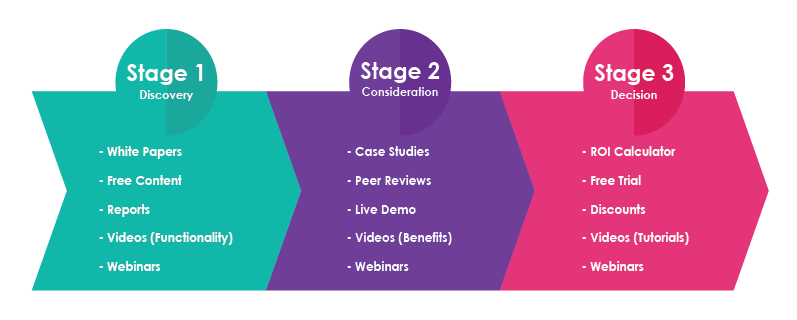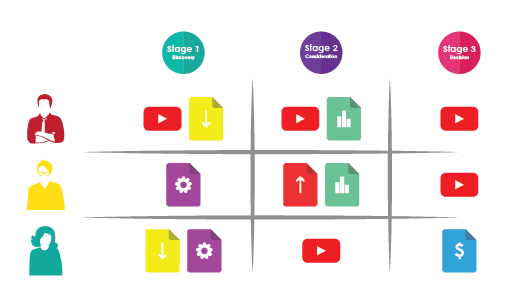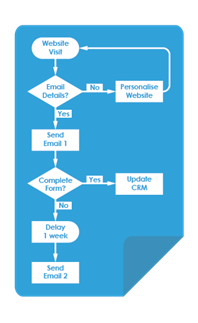THE CMO'S 6 STEP GUIDE TO CREATING A SUCCESSFUL MARKETING AUTOMATION PLAN
 Many organisations use marketing automation to some degree, but few do it well. I can’t even begin to count the number of times I've received totally irrelevant, non-targeted emails from organisations I've willingly handed my contact details to. Part of the problem is that it’s too easy for marketers to set up an automated Marketing process and call it good. All too often, little planning goes into the creation of an automated marketing scheme, but this is understandable because it’s hard to know where to start.
Many organisations use marketing automation to some degree, but few do it well. I can’t even begin to count the number of times I've received totally irrelevant, non-targeted emails from organisations I've willingly handed my contact details to. Part of the problem is that it’s too easy for marketers to set up an automated Marketing process and call it good. All too often, little planning goes into the creation of an automated marketing scheme, but this is understandable because it’s hard to know where to start.
Well, here at 3chillies we go by the motto of the 5 P’s - Prior Planning Prevents Poor Performance, so we've written this post which outlines the process for creating a targeted nurturing plan for your customer base.
For the most part, it isn't necessary to have any Marketing Automation Software in place before you start this exercise. In fact, this would be a very good exercise to complete before you make the purchase. When it comes to actual implementation, you’ll need to ensure that you have a top performing Marketing Automation Platform in place. We’re Sitecore gold partners, so the Sitecore experience platform is the natural choice for us.
We’ll start by briefly touching on the meaning of the term Marketing Automation, then dive straight into the step by step process of creating a robust, profitable Marketing Automation plan so that you can put your email database to good use.
WHAT IS MARKETING AUTOMATION, AND IS IT FOR ME?
“Marketing Automation is the practice of using technology to automatically manage the targeting, timing, and content of your outbound marketing messages in response to a prospect’s inbound actions and on-line behaviours.” Put more simply, the prospect shows some interest in your product or service and the system automatically sends that prospect the right marketing messages at the right time.
Every organisation stands to benefit from Marketing Automation, regardless of their size, structure, or service offering. B2B organisations can take the heavy lifting out of lead nurturing, lead scoring, and buyer journey management, whilst B2C companies can automate specific processes such as cross-selling and up-selling.
Now that we’ve covered the basics, let’s start to look at the steps involved in creating a targeted nurturing plan.
STEP 1. UNDERSTAND YOUR BUYER JOURNEY
I've defined the Buyer Journey as “The path, or sequence of actions, a prospect takes leading up to the purchase of a product or service”. The buyer journey is typically made up of multiple touch points – recordable actions where the prospect interacts with your brand or organisation in some way.
It's important to recognise that each and every customer journey is different. One customer may have read a certain article that another has not, or maybe one customer clicked on a particular call-to-action button, whilst another completed a registration form. They might all go on to purchase your product, but they’ll almost certainly go on a unique journey to get there.
Each prospect will be at different stages in their buyer journey too. Some will be close to purchasing whilst others will be doing initial research, so it’s also important to fully understand your buyer journey, because without knowing where a prospect is in their journey, you’ll likely end up sending them an untimely email.
Whilst every journey is unique, for most organisations, the buyer journey can be divided into 3 stages:
Stage 1 (Discovery) - The buyer begins researching the name and scope of their problem or opportunity.
Stage 2 (Consideration) - The buyer has defined the problem or opportunity and begins to search for strategies to overcome / fulfil them.
Stage 3 (Decision) - The buyer has decided on a strategy and is assembling a list of suppliers before making the purchase.
So now that we’ve divided the buyer journey into three definitive stages, we can begin to work out which marketing content is most appropriate for each stage.
STEP 2. CATEGORISE YOUR CONTENT
According to the State of Demand Generation Report, "76% of buyers prefer different content at each stage of their research". So in this step you’ll need to perform a partial website content audit to figure out which content to serve each prospect at each stage of the journey. You don’t need to go into too much detail, just make a list of all the digital content you offer through your website, and get a feeling for which stage of the customer journey that content belongs to.

You could use analytical software to categorise the content into the different stages, but this could take an awfully long time to achieve. I would recommend going with your gut feeling: If it’s obviously high-level content like a white paper that describes what you product is, it belongs in the discovery stage, and if it’s a piece of content that you’d expect a prospect to look at when they’re on the cusp of making a purchase decision, like an ROI calculator or free trial, it’s Stage 3 type content. A list of examples are shown in the image above to help you with this categorisation process.
Spend a reasonable amount of time on this. Changing the categorisation at a later stage could cause a lot more work than expected, especially if certain content is being used in multiple different marketing automation plans.
By categorising the content into a specific stage of the buyer journey, we can monitor each prospect’s movements and get a better understanding of where individuals are in the buyer journey and knowing that will help us better target our emails.
Remember, not every customer will begin their journey with you at the Discovery stage: Many will have performed research before coming across your organisation, so we shouldn't treat every new prospect in exactly the same way.
STEP 3. IDENTIFY BUYER PERSONAS
All buyers are different – content that appeals to one prospect might not appeal to another, despite them both being at the same stage in the buyer journey. If we take this into consideration, there is another opportunity to identify and serve the most relevant content to each prospect, boosting our chances of customer engagement.

Despite the prospects’ differences, we can categorise them into target groups based on big-picture metrics such as perceived success factors, perceived barriers, buyer journeys and buying triggers. These segregated customer groups are called personas. A Persona is a composite picture of the real type of people who buy, or might buy, products and services like the ones that you sell.
We won’t go into too much detail about creating personas since there are plenty of great guides available elsewhere.
STEP 4. MAP CONTENT TO PERSONAS
In step 2, we segregated the content into the three stages of the buyer journey. Now we are going to split the content up a little further, assigning the content to persona types. So go back to your content audit and start assigning each piece of content to a persona type. As you’ll see from the image below, it’s possible that one piece of content will appeal to more than one persona type, so it’s important not to eliminate that possibility.

Let’s consider a quick example:
A cost-focused Managing Director, an efficiency-focused CMO, and a technology-focused IT Director will all have different thought processes, yet all are influential in the decision to invest in a new high performing website for their organisation. Assuming that each persona type starts at the discovery stage of the buyer journey, they’ll each be looking for different things as their immediate port of call:
- The cost-focused Managing Director is likely to want to see ball park figures
- The efficiency-focused CMO is likely to want to see statistical data on the benefits
- The technology-focused IT Director is likely to want to know about the underlying technologies and system requirements.
Now, when a prospect interacts with certain content on your website, the system can more easily identify both their position in the buyer journey and their Persona type, and enter that prospect into a relevant automated email nurture programme.
STEP 5. CREATE EMAIL PROGRAMMES AND NURTURE FLOWS
Now for the part we've all been waiting for, let’s start creating relevant email nurture programmes for our prospects.
The emails that we create will be entered into a nurture flow diagram. A nurture flow diagram is usually presented in the form of a flow chart, and it is this flow chart that triggers the underlying technology to perform actions such as sending a specific email, or writing information to the CRM system.
I recommend that you create a nurture flow for each persona type that you have identified. Start with the most important persona (the one generally most likely to buy) because it can take some time to create a very good nurture flow. In order to nurture the customer relationship effectively, we recommend sending a minimum of 3 emails at each stage of the buyer journey, so a minimum of 9 in total per persona. A 5 to 10 day waiting period should be placed between each email that is sent to the client. Therefore, with 3 emails sent at each stage of the buyer journey, we have created a 45 to 90-day nurture programme for prospects that begin at the discovery stage. If a typical buying journey is greater than 90 days in length, more content should be created.
The automated emails should be personalised based upon the content map that we created in step 4, and just a short email with links to the relevant piece of web content will be sufficient enough to shepherd the customer journey.
As the prospects flow through the chart at different rates, it is easy to imagine how difficult it would be to achieve the same level of targeted marketing if this were a manual process, even with a very simplistic automation plan such as this one:

STEP 6. ACCELERATE NURTURE
Some browsing patterns may make it difficult to accurately define the position of that prospect in the buying journey. For these prospects, we switch to the accelerated nurture model.
The accelerated nurture model assumes that the prospect joins you when they are already at stage 3 of the buying journey. If the customer truly is on the cusp of closing the deal, content from the Discovery and Consideration stages would cause an unnecessary speed bump in the sales process. To overcome this ultimatum, stage 3 content should be served to the customer as a top priority. This ensures that the most relevant information is sent to them at the best time possible. After all, sending an “About product x” video would be totally irrelevant if they’re about to close the deal with a product x supplier.
What happens if the prospect doesn't interact with the content from stage 3? …They're simply moved down through the other stages until interaction does take place.

If you have followed all of the steps above, and you've managed to put together some compelling email content, you should be well on your way to creating more leads. In fact, the DemandGen Report states that “Nurtured leads produce, on average, a 20% increase in sales opportunities versus non-nurtured leads.”
If you’d like to learn more about Sitecore, the software we use for our nurturing programmes, please do get in touch.